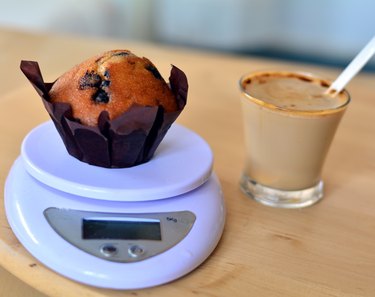
If only weight loss were as simple as weighing food. Investing in a food scale can help you keep portions in check, but it's not the only factor you need to take into consideration when you're aiming to get to a healthier weight. Consult with your doctor before attempting any weight-loss plan.
Why Weighing Food Matters
Video of the Day
Losing weight requires lifestyle changes that affect energy balance, according to the January 2016 position statement from the Academy of Nutrition and Dietetics (AND) on interventions and treatments for the management of overweight and obesity, which was published in the Journal of the Academy of Nutrition and Dietetics. Put more simply, to lose weight, you must take in fewer calories than those you burn.
Video of the Day
Although exercise is a pivotal part of the weight-loss equation, what you eat may have more of an effect, according to an August 2012 study published in Obesity. The study researchers found that diet-only interventions helped participants lose 8.5 percent of their body weight over the 12-month study period, while exercise-only interventions produced only 2.4 percent loss. For the record, the group that followed a weight-loss diet and exercise program lost the most at 10.2 percent.
Weight loss isn't about simply weighing food — it's about calories. The number of calories you need each day to lose weight depends on your sex, age, current weight, weight-loss goals, activity level and overall health. According to the AND, most women can lose weight consuming 1,200 to 1,500 calories a day, and most men can slim down by eating 1,500 to 1,800 calories.
Monitor your rate of weight loss to help you adjust calorie intake. Most health experts agree that you shouldn't lose more than 2 pounds a week. Losing too much too quickly may mean you're losing muscle mass, which can affect energy levels and stall your weight-loss efforts.
Read more: The Ultimate Guide to Fat Loss
Eating What Matters
Calories are a big player in the weight-loss game, but the types of foods you spend your calories on matter too. Losing weight is easy, but keeping it off is hard. To successfully lose weight, you need to look at your weight-loss plan as a new lifestyle, not a quick fix, says the AND. The types of foods you include may help or hurt your efforts.
A healthy weight-loss diet should include plenty of fruits and vegetables. Low in calories, rich in vitamins and minerals and a good source of fiber, fruits and vegetables keep hunger pangs away and energy levels up. Whole grains, such as brown rice, quinoa and whole-wheat bread, are better sources of nutrients than their refined counterparts. They're also a good source of fiber, which helps you feel full.
For protein and calcium without excess calories, choose low-fat dairy or plant-based substitutes, such as low-fat yogurt or soy milk. Round out your plan with lean sources of protein such as poultry, fish and seafood, lean red meats and beans.
It's OK to include treats when you're trying to lose weight. Cutting out your favorite treats may set you up for failure. Just be mindful of calories and portions to keep your overall calories in balance. Use an online food diary to help you track calories and nutrient intake.
Read more: How to Find the Best Weight-Loss Diet for You
Weighing Food for Portion Control
The AND suggests that portion-controlled plans are very effective at helping people lose weight and keep it off. Weighing food is a good way to keep portions in check and may make you more aware of portion sizes. Some scales even provide nutrition information, such as the amount of carbohydrates.
When weighing food on a food scale it's important to know basic portions and weights. For example:
- 117 grams (4.1 ounces) of cooked whole-wheat pasta = 174 calories
- 182-gram (6.4-ounce) apple = 95 calories
- 156 grams (5.5 ounces) of cooked broccoli = 55 calories
- 170-gram (6-ounce) cooked salmon fillet = 309 calories
- 29 grams (1 ounce) of low-fat Swiss cheese = 50 calories
Weighing food at home is easy, but you may not be able to take your food scale everywhere you go. The Mayo Clinic suggests using familiar objects to help keep portions in check when you don't have your food scale.
- One baseball = 1 cup (8 ounces or 227 grams)
- One tennis ball or hockey puck = 1/2 cup (4 ounces or 113 grams)
- Deck of cards = 3 ounces (85 grams) of meat, chicken or fish
If the use of food scales, measuring cups and familiar objects aren't helping you with your weight loss, use your plate to keep calories and portions in check. Fill half your plate with vegetables, one-quarter with protein and one-quarter with whole grains. Add low-fat yogurt or a piece of fresh fruit to round out the meal.
- Journal of the Academy of Nutrition and Dietetics: "Position of the Academy of Nutrition and Dietetics: Interventions for the Treatment of Overweight and Obesity in Adults"
- Obesity: "Effect of Diet and Exercise, Alone or Combined, on Weight and Body Composition in Overweight-to-Obese Postmenopausal Women"
- American Academy of Family Physicians: "What It Takes to Lose Weight"
- Today's Dietitian: "Food Scales"
- USDA: "Whole-Wheat Pasta, Apple, Broccoli, Salmon, Low-Fat Swiss Cheese"
- Mayo Clinic: "Portion Control Guide"